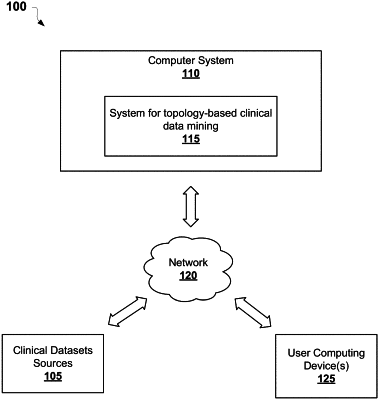| CPC G06F 16/26 (2019.01) [G06V 10/762 (2022.01); G06V 10/7715 (2022.01); G06V 10/84 (2022.01); G16H 10/20 (2018.01); G16H 50/70 (2018.01)] | 20 Claims |

|
1. A system for graph-based discovery of geometry of clinical data, the system comprising:
at least one processor; and
a memory communicatively coupled with the at least one processor, the memory storing instructions, which when executed by the at least processor performs a method comprising:
receiving vectors of outcomes of trial subjects;
generating, based on the vectors of outcomes, a plurality of metric graphs, each of the metric graphs including:
a same set of nodes corresponding to the vectors of outcomes; and
a set of edges, wherein generating the set of edges includes:
transforming the vectors of outcomes to generate data points;
selecting a projection rule from a set of projection rules;
applying the selected projection rule to the data points to obtain projections of the vectors of outcomes; and
for each of a first node and a second node from the same set of nodes:
determining that a first projection and a second projection of the projections satisfy similarity criteria, the first projection corresponding to the first node and the second projection corresponding to the second node; and
based on the determination, selectively connecting the first node and the second node;
selecting, from the plurality of metric graphs, an optimal graph;
performing an automatic search to identify at least one community of nodes in the optimal graph;
displaying a graphical representation of the optimal graph; and
highlighting nodes in the graphical representation, the nodes corresponding to the at least one community of nodes.
|